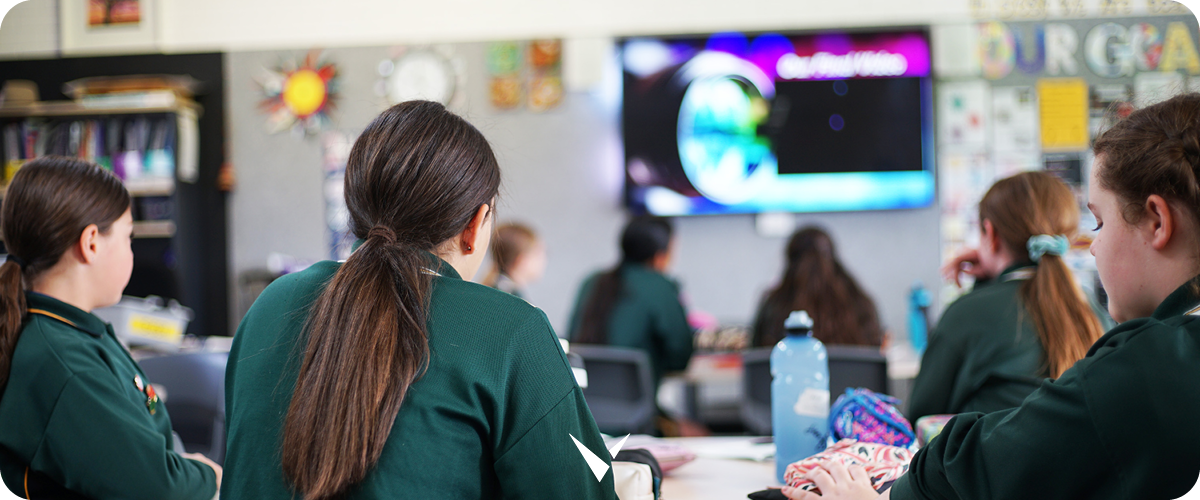
We all want better outcomes for our students. That’s what education is all about. But with the challenges of the pandemic, virtual learning, and hybrid learning, teachers grapple more and more about how to improve student engagement in the classroom.
With the advance of virtual learning, interactive classroom technology, and laptops at every desk, school districts have a myriad of choices when it comes to companies, devices, and interfaces for teachers to use. The pandemic accelerated educational technology programs in school districts out of necessity, but this paradigm is here to stay.
Ultimately, schools need to identify technology that will not only effectively engage students in the classroom but also integrate seamlessly with existing tech to keep costs low and major changes minimal.
The right technology for engaging students will also be the right technology for teachers–ultra simple but with great versatility.
It’s vitally important to make the correct choice for your classroom technology because your teachers need to maintain the interest of students while also seamlessly using the hardware without any hiccups.
Discover how to improve student engagement in the classroom, even as educators face almost daily challenges to keeping pupils interested in learning.
Statistics to Understand About How to Improve Student Engagement in the Classroom
As many as 1.3 million students may have disengaged from their schools in the late spring of 2020, according to an internal analysis from a company that sends reminders, texts, and emails to students. The average rate of disengagement dropped anywhere from 8 to 17 percent among students across all 50 states.
A survey conducted by the Idaho State Department of Education paints an even more dismal picture.
Only 45.7 percent of students reported being engaged with their school in 2021 across the state. That’s starkly lower than 52.6 percent in 2019 and 65 percent in 2018, notes Idaho Ed News.
Of course, the pandemic changed everything.
But school districts must learn to adapt and continue to teach to their students.
Another challenge teachers face comes from students who may not do well in the traditional, five-day-a-week, in-person school setting. Educational publisher McKinsey noted that according to a survey conducted in 2021, one-third of the 16,370 parents surveyed (across all 50 states) said that when pandemic restrictions fully ease, they believe their children would do better in an educational setting other than the traditional five days in a physical classroom.
The survey indicates that teachers need to develop strategies for how to improve student engagement in the classroom for pupils who don’t thrive in this environment.
Related: The hardest part of a teacher’s job, according to a report on “Using technology in the classroom to better engage students”
Student Engagement Linked to Student Achievement
In most instances, student engagement goes hand in hand with student achievements. Student achievement can soar to new heights when teachers opt for strategies that capture students’ attention while involving them in the learning process.
A comprehensive Gallup survey conducted in 2019, covering 128 schools and more than 110,000 students, found that student engagement and hope were significantly positively related to student academic achievement and growth in math, reading, and all subjects combined. Further, students who were more engaged in their schools were more prepared for math and writing in higher education settings.
Gallup noted that schools in the top quartile of student engagement had significantly more students exceeding and meeting standards compared to schools in the bottom quartile of engagement.
That comprehensive survey focused entirely on student engagement.
The level of a student’s engagement can determine whether or not they will achieve significantly down the line. Also, students stand a better chance of achieving deep, meaningful learning when they engage proactively.
Do you want to see better results in your classroom? Read about how to improve student engagement in the classroom with some viable strategies that can considerably change your students’ outcomes.
Choosing the Right Classroom Technology to Foster Student Engagement
Classroom technology, including screen mirroring technology, can enhance student engagement and outcomes in relevant ways by enhancing the physical learning environment.
Wireless technology in the classroom sets a simple example: The teacher understands and gets kids.
Teachers realize that their students, even in elementary school, may prefer to look at their devices in school. Why listen to the teacher when they can watch videos on their phones?
Teachers can set the example by utilizing the same type of wireless tools that the students themselves use at home. Would students pay more attention to a teacher carrying around a tablet and walking through the rows of desks versus a teacher stuck behind a desk?
Probably.
Use Classroom Technology to Enhance Lessons.
Every student is unique, but most kids learn by four basic methods: visual, auditory, reading and writing, and kinesthetic.
In-classroom technology fosters all four learning types. For example, your teacher has a lesson about trigonometry and how to measure angles. The students probably wonder why this is important.
The educator holds a wireless tablet and sends a video to the interactive display towards the front of the class. It shows a video about someone about to launch a simple, air-powered rocket. The people in the video want to determine at what angle to launch their rocket in order to achieve the greatest distance.
After watching the short video a couple of times (and pausing it in the appropriate places), the teacher puts a diagram with written instructions on the display so the children can build their own air rockets and conduct an in-classroom experiment.
After everyone determines the outcomes, they share their results on the screen as a way to report to the class.
This type of lesson takes into account all four learning types and the practical part of launching a rocket as a real-world application.
Of course, students want to know how measuring angles apply to their lives. Throwing a baseball, shooting a basketball, and hitting a golf ball use angles. You need to understand angles to drive a car when you turn the wheel. Climbing a ladder requires angles because you need to be safe.
These real life examples can come to life using wireless technology to engage students in each step of the learning process.
Use Classroom Technology to Tap Into Your Student’s Individual Interests.
Not everyone in class will find air rockets interesting.
Educational technology allows you to cater lessons to each student. Rather than recording angles and distances about an air rocket, have the gamers in class record the correct angles they need to jump at ledges in a video game. Decorative types can assess the best angles for hanging ribbons from lights based on distances away from walls or other fixtures.
For statistics, kids can measure Instagram followers on their favorite celebrities, how long it takes to defeat a particular boss in battles on a video game, or even how their pet does when trying to teach their furry family member a certain trick.
All of these lessons have real-world applications, which is the key to long-term memory retention, and all can be quickly and easily displayed for class discussion using wireless technology.
Use Classroom Technology for Greater Accountability.
How can teachers possibly keep an eye on everyone in class?
Wireless devices have the ability to use screen mirroring technology in the classroom, no matter what device the teacher uses (smartphone, tablet, Android, Apple).
A teacher has a lesson about the human heart on the class display. As the educator maneuvers images and videos on a tablet or other device, he or she can walk around the classroom to see what students are doing at their desks.
It’s subtle because students think the teacher is focused on the lesson. They see the teacher looking at the screen in their hands, hear them talking about what’s on the display, and know they’re continuing with the lesson.
But teachers are trained to multitask in this regard. They can talk, walk, and monitor at the same time.
Screen mirroring to a display from any device allows teachers to multitask very easily to keep an eye on students to see how they are doing with the lesson.
This may help keep a well-controlled classroom, but it can also help the teacher identify students who need extra help with the activity.
Classroom technology makes learning fun
You can’t expect all of your students to enjoy every lesson 100% of the time.
But a fun education is a memorable one, and when students enjoy their classroom time they are more engaged with it.
Another thing to consider is that when you make learning fun, the modern reality is that students have an opportunity to escape, at least internally, from whatever stresses they feel at home. Smiling kids are happy kids, and happy kids learn better.
Related: The Purpose of Technology in the Classroom
Combining Classroom Technology With Tried-and-True Learning Concepts
Classroom technology offers a fantastic solution to keeping modern students engaged with their lessons. But teachers still need to rely on tried-and-true learning concepts to foster better outcomes.
Create an Active Learning Experience
You can’t think about how to improve student engagement in the classroom without considering the overall learning experience. Students need to discuss what they see, hear, feel, and do.
Give them enough opportunities to share their thoughts and ideas. Make room for discussions on every topic that you handle with your class.
Teachers can take notes from their students and post them on the display at the front of the class, giving kids a sense of accomplishment and encouragement to talk about the lesson even more.
Teachers who give students a voice help them take ownership of the tasks and maintain engagement during their sessions. Such approaches encourage students to take an active role in their classes.ffxy
Offer Personalized Learning
While some students have little trouble understanding certain concepts, others take longer to grasp the lessons. Find ways to keep everyone in your class engaged by introducing personalized learning techniques.
For example, you could ask students what they want to do when they grow up or get older. Assessments and journal entries also provide an excellent opportunity for students to share their knowledge and engage better during lessons.
Engage With Students First Before Starting Lessons
Anyone looking for success in the classroom should interact with the students personally before getting into the course material.
The most successful approach would be to try and ignite students’ interest before moving on to the content. What’s more, the engaging piece doesn’t have to relate directly to the course material.
Given that students must choose to learn, you can simplify this choice by stimulating students’ curiosity about the topic and creating a solid connection in the first lessons. This approach will result in consistent engagement.
Explore Flexible Seating Options
Rows of desks offer a more conventional approach, but they aren’t always the best way to learn. Students who attend classes the whole day may get bored sitting at their desks. Going for flexible seating options lets your students learn in an adaptive environment.
You could introduce some comfortable bean bag chairs for reading lessons or an exercise ball suitable for social studies classes. Even the most reluctant learners will find such classes more fun. Stools, moving desks into a circle, and even standing up for 20 minutes can break the monotony of the day.
Integrate Screen Mirroring Technology Today to Help Teachers Engage With Their Students
Bring in a screen mirroring platform, like Vivi, as a way to get students to engage, sharing their work with each other and the teacher. Vivi works wirelessly with the devices and displays your teachers already have, allowing seamless interaction without complication or wires.
The technology is life-changing and adaptive, but also simple. Request a demo of this technology today, trusted by more than 40,000 classrooms and counting.



